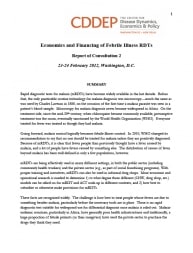November 27, 2013

The Question
This consultation continues a process that began in Seattle in October 2011. It provides an opportunity to discuss the past experience with large-scale interventions to expand RDT use in both public and private (formal and informal) sectors, and urban and rural settings. Additionally, trajectories for expansion in countries where RDT use remains low will be discussed with questions, such as whether the initial focus should be on the formal sectors (public and private) where there is a greater likelihood of success, or on the informal sector where antimalarial use is greatest and where the potential for reducing deaths and for mitigating the inappropriate use of both antibiotics and antimalarials is also the greatest. RDT/ACT bundling at different levels of subsidy will also be discussed. The third set of issues relates to the trajectories for expanding RDT use in a world witnessing ongoing financing for antimalarials but declining global health resources. Finally, with inputs from participants, an agenda will be established for the following 18 months of analytical work and consultations to better define the best way to finance and treat febrile illness in a world with possibly less malaria and certainly fewer resources.
Why it matters
Rapid diagnostic tests for malaria (mRDTs) have become widely available in the last decade. Before that, the only practicable routine technology for malaria diagnosis was microscopy much the same as was used by Charles Laveran in 1880, on the occasion of the first time a malaria parasite was seen in a patient’s blood sample. Microscopy for malaria diagnosis never became widespread in Africa. On the treatment side, since the mid-20th century, when chloroquine became commonly available, presumptive treatment was the norm and it was eventually sanctioned by the World Health Organization (WHO). Everyone who were treated for fever were treated as though they had malaria.
Going forward, malaria control logically becomes febrile illness control. In 2010, WHO changed its recommendation to say that no one should be treated for malaria unless they are positively diagnosed. Because of mRDTs, it is clear that fewer people than previously thought have a fever caused by malaria, and a lot of people have fevers caused by something else. However, the distribution of causes of fever beyond malaria has been well defined in only a few populations. mRDTs are being effectively used in many different settings, in both public sector (including community health workers) and private sector (as part of social franchising programs, for instance). With proper training and incentives, mRDTs can also be used in informal drug shops. More economic and operational research is needed to determine the degree to which these different (CHW, drug shop, etc.) models can be relied upon for mRDT and ACT scale-up in different contexts and the best way to subsidize or make provisions for mRDTs.
These facts are recognized widely. The challenge is how best to treat people whose fevers are due to causes other than malaria, particularly before the necessary tools are in place. There is no rapid diagnostic test suitable for widespread use for differential diagnosis once malaria is ruled out. Malaria-endemic countries, particularly in Africa, have generally poor health infrastructures and traditionally, a large proportion of febrile patients (or their caregivers) have used the private sector to purchase the drugs they think they need.

